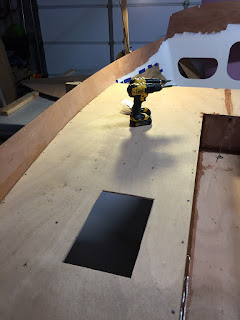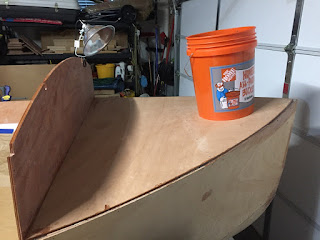I epoxied the bow board decking last week, but then the manual calls for fillets underneath. With the larger hole on the starboard side of bulkhead #2, you can reach underneath and access the area, but it is not easy. On the port side of the boat, there is a smaller hole to access the area. Since I am planning on having an electrical panel, I went ahead and did some quick measurements and cut the hole. This allow me better access to the area. The fillets look so so, but they will do the job and no one will see them.
 |
| Picture showing the cutout for the electrical panel and for better access. |
I started to fit the rear cabin wall and got the angle from the plans. I also wanted to get the actual seat back panels and use them to make sure everything is lining up correct. Below is the rear cabin wall stitched in.
I decided to put a coat or 2 of epoxy on the seat back frames before I installed them. I used a clothes hanger I cut and used the stitching holes to hang them.
Below is the seat back frames glued in place with a hot glue gun. I am glad that I use that glue instead of epoxy, because where I put them they are too high. They need to be move more towards the bow, so they will be flush in height with the upper side panels. The glue holds them just enough and were easy to break away. I will re-glue them this weekend.
I had already glued the upper side panels and fiberglassed them last year, but I didn't sand them since I wanted to move on to something else and really didn't have the work room then. So, I had to use a plane to get the sharp edges of fiber glass off and then sand the fiberglass side to a grey color. I then stitched them to both sides. I still have some adjustments I need to do before I start to tack welds.
 |
| Starboard Upper side panel. |
 |
| Overhead view. |
 |
| Bow view of the upper side panels. They lined up very good. |



































